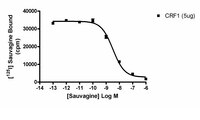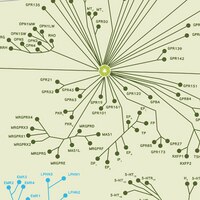HTS023M Sigma-AldrichChemiSCREEN™ CRF1 Membrane Preparation
Human CRF1 GPCR membrane preparation for Radioligand binding Assays & GTPgammaS binding.
More>> Human CRF1 GPCR membrane preparation for Radioligand binding Assays & GTPgammaS binding. Less<<Prodotti consigliati
Panoramica
Tabella delle specifiche principali
| Species | Host Cells | Protein Target |
|---|---|---|
| Human | Chem-1 | CRF1 |
| Product Information | |
|---|---|
| Format | Membranes |
| Presentation | Liquid in packaging buffer: 50 mM Tris pH 7.4, 10% glycerol and 1% BSA no preservatives.Packaging method: Membranes protein were adjusted to 0.5 mg/ml in 1 ml packaging buffer, rapidly frozen, and stored at -80°C. |
| Quality Level | MQ100 |
| Product Usage Statements |
|---|
| 5 µg/well | |
|---|---|
| Signal:Background | 13.2 |
| Specific Binding (cpm) | 31785 |
Usage Statement
- Unless otherwise stated in our catalog or other company documentation accompanying the product(s), our products are intended for research use only and are not to be used for any other purpose, which includes but is not limited to, unauthorized commercial uses, in vitro diagnostic uses, ex vivo or in vivo therapeutic uses or any type of consumption or application to humans or animals.
| Storage and Shipping Information | |
|---|---|
| Storage Conditions | Maintain frozen at -70°C for up to 2 years. Do not freeze and thaw. |
| Packaging Information | |
|---|---|
| Material Size | 200 assays |
| Global Trade Item Number | |
|---|---|
| Numero di catalogo | GTIN |
| HTS023M | 04053252469596 |










